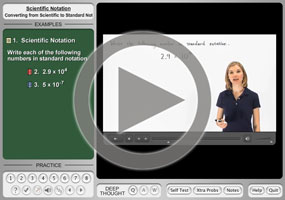Exponents: Engineering Notation
Purplemath
What is engineering notation?
Engineering notation is similar to scientific notation, in that numbers are converted to (a number) times (10 raised to some power). But the powers in engineering notation will always be multiples of 3.
Because the powers are always multiples of three, the resulting numbers correspond to our common names for numbers, such as millions, billions, and trillions (and millionths, billionths, and trillionths).
Content Continues Below
For instance, 13,460,972 is thirteen million and some. In the newspaper, this number would probably be abbreviated as "13.5 million". In engineering notation, you would move the decimal point six places to the left to get 13.460972 × 106. Once you get used to this notation, you recognize that 106 means "millions", so you would see right away that this is around 13.5 million.
Any time you see a reference to some number of millions or billions or trillions, rather than a complete enumeration of the entire number with all its digits, the writer is, in effect, using engineering notation.
Is engineering notation between 1 and 1,000?
Since engineering notation converts numbers to their units (millions, say, or millionths), the coefficient will be between 1 and 999. If the coefficient were 1,000, then the number would not have been converted properly, since this would be, say, "a thousand million" when it should have been converted, in this example, to "one billion".
In other words, in engineering notation, there should be between one and three digits to the left of (that is, before) the decimal point. And if there is just one digit before the decimal point, that digit must be an "interesting" number, so that digit cannot be zero.
What are some examples of engineering notation?
The following is an example of converting a "regular" number to engineering notation.
- Express 472,690,128,340 in engineering notation.
This is a twelve-digit number. I need to move the decimal point from the end of the number toward the beginning of the number, but I must move it in steps of three decimal places.
Affiliate
In this case, I must move the decimal point to between the 2 and the 6 (that is, to the location in the original number of the first comma), because this will leave nine digits (and nine is a multiple of 3) after the decimal point, and no more than three digits before the decimal point.
(Yes, 12 is a multiple of 3, but if I move the decimal point twelve places to the left, I'll have no non-zero digits to the left of the decimal point. This would be wrong; it would be like saying "about 0.4 quadrillion", which is just silly. I have to have non-zero stuff to the left of the dot so, in this case, I have to stop at nine decimal places.)
This is a large number and I moved the decimal point nine places, so the power on 10 will be a positive 9. Then the answer is:
472.690128340 × 109
...or about 472.7 billion.
It may be simpler to think in terms of commas when converting larger numbers to engineering notation, because those commas are placed specifically in "regular" numbers in order to demarcate hundreds from thousands, thousands from millions, millions from billions, and so forth. So just look for the comma furthest to the left, and move the decimal point to that location.
- Express 83,201 in engineering notation.
I need to move the decimal point over to the left in sets of three digits (that is, in comma-delimited groups of digits). I can't move the decimal point any further than to the left of the 2, which is three places, so the answer is:
83.201 × 103
...or 83.201 thousand.
Content Continues Below
When working with small numbers (that is, with numbers whose interesting digits are all the right of the decimal point), we don't have commas, but we can still think in terms of sets of three.
- Express 0.000 063 8 in engineering notation.
I need to move the decimal point over in sets of three. If I move the decimal point to the right three places, I'll be left with "0.0638", which won't do because it'll leave me with just zero to the left of the decimal point. If I move the decimal point to the right nine places, I'll get "63800", which is too many digits to the left of the decimal point. So I need to move the decimal point six places.
Since this started out as a small number, the power on 10 will be negative; since I moved the decimal point six places, the power will be a negative 6. Then the answer is:
63.8 × 10−6
...or 63.8 millionths.
- Express 0.397 53 in engineering notation.
I need to move the decimal point to the right three places. Since this started as a small number, the power on 10 will be negative:
397.53 × 10−3
...or 397.53 thousandths.
You should notice that, in engineering notation, it is perfectly okay to have more than one digit to the left of the decimal point; in fact, you should expect to have something other than always only one digit. Just make sure that the power on 10 is a multiple of three.
URL: https://www.purplemath.com/modules/exponent4.htm
Select a Course Below
Standardized Test Prep
Homeschool Math
© 2024 Purplemath, Inc. All right reserved. Web Design by ![]()



